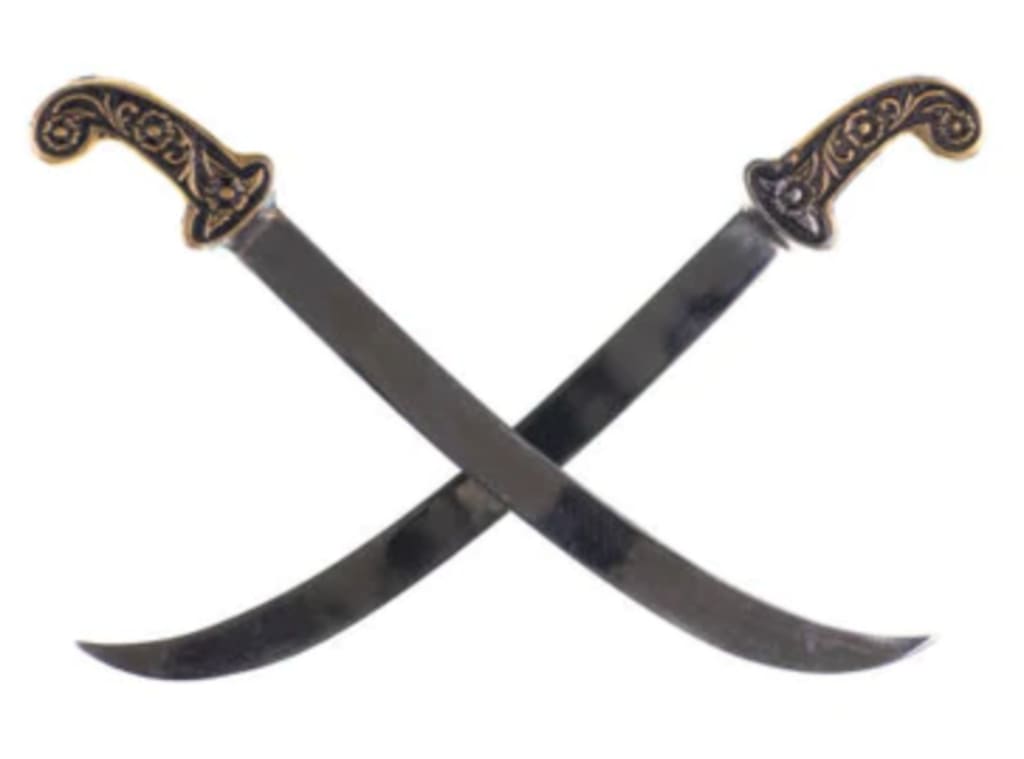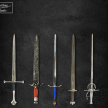
The Scimitar, a curved sword steeped in history across various cultures, boasts a rich legacy. Among its iconic variants, the two-handed Scimitar of the East, known as the deadly Scimitar, stands out as a masterpiece of craftsmanship and a symbol of power, inspiring countless legends.
Let’s embark on a journey to explore the origins, features, and significance of the deadly Scimitar, while also delving into its notable wielders and battles. From Arabia to Persia, this two-handed Scimitar has made an indelible mark on the world of deadly weaponry.
Whether you’re a collector or a history enthusiast, the mystique of this sword promises something captivating. Join us as we unveil the secrets concealed within the deadly two-handed Scimitar.
Unveiling the Ancient Origins and Evolution of the Deadly Scimitar Sword
The Scimitar, a lethal weapon with a captivating history spanning millennia, traces its roots to ancient Persia. Nomadic tribes in the region first employed it as both a tool and a weapon.
Over time, the Scimitar evolved into a symbol of power and prestige among the Persian aristocracy. Master blacksmiths were commissioned to craft exquisite examples of this deadly blade.
As Persian influence spread throughout the Middle East and North Africa, so did the deadly Scimitar. It became a staple for armies and mercenaries, celebrated for its curved blade and exceptional cutting prowess. Warriors wielded it with one hand, complemented by a shield in the other, charging into battle with formidable force.
During the 13th century, the Mongols invaded Persia, introducing their version of the Scimitar, designed for mounted combat. This led to the development of lighter and more agile scimitars suitable for close-quarters combat.
In the centuries that followed, the deadly Scimitar featured prominently in numerous battles and conflicts, wielded by Crusaders, Ottoman warriors, and even pirates. The Ottoman Empire continued to employ the Scimitar in battle, marking its last known use during the First World War. Today, the legacy of the deadly Scimitar endures, captivating sword enthusiasts and history lovers worldwide.
The Art of Crafting the Two-Handed Scimitar Sword
The deadly two-handed Scimitar represents a pinnacle of craftsmanship, forged from the finest materials and techniques. Damascus steel, renowned for its superior strength and intricate patterns, is the preferred material for creating this lethal, curved blade.
Another key material, High Carbon 1095 Steel, known for its edge retention and toughness, complements the Scimitar’s construction. These materials were carefully chosen for their unique qualities, combining toughness, sharpness, and longevity.
Materials Used Damascus steel, characterized by its distinctive iron and steel layering pattern, offers superior toughness and sharpness, making it an ideal choice for scimitars.
High Carbon 1095 Steel, renowned for its hardness and strength, further enhances the blade’s performance. Together, these materials yield a strong, sharp, and visually striking Scimitar.
Why These Materials are Preferred The preference for Damascus and High Carbon 1095 Steel in crafting scimitar swords is rooted in their exceptional physical properties. Damascus steel blends carbon and iron to provide toughness, while High Carbon 1095 Steel offers hardness and strength.
Additionally, these materials are malleable and forgeable, allowing artisans to create intricate and unique designs.
Why Scimitars are Curved The curve of the Scimitar enhances its cutting capabilities, allowing it to make deeper cuts by striking a larger surface area. The curved shape enables smooth, swift strikes and direction changes.
Moreover, the curvature concentrates force onto a smaller area, making the Scimitar effective at penetrating armor. Over time, the sword’s design was perfected for battlefield efficiency.
The Hand-Crafting Process Crafting a two-handed Scimitar sword is a labor-intensive endeavor that requires the skill and patience of a master blacksmith. The process involves:
Folding and forging metal layers to achieve the desired shape and pattern.
Quenching and tempering the blade to enhance its strength and durability.
Handcrafting the hilt, pommel, and guard once the blade is ready.
Sharpening, polishing, and engraving intricate designs and patterns unique to the maker and cultural tradition.
The result is a breathtakingly beautiful and deadly weapon that embodies the mastery of traditional craftsmanship.
Varieties of Scimitar Swords
Arabian Scimitar: This unique blade showcases exceptional craftsmanship and historical significance. Crafted from high-carbon Damascus steel, it features a longer blade and a distinctive handle design, reflecting both aesthetic preferences and combat techniques.
Eagle Scimitar: Boasting a broad 32" blade made of high carbon 1095 steel, the Eagle Scimitar offers agility and robustness. Its handle design accommodates diverse fighting styles, making it a versatile choice for combat enthusiasts.
Shamshir Sword: Known for its deeply curved blade, the Shamshir Sword is a notable Scimitar variant. The two-handed Shamshir Scimitar exemplifies Persian craftsmanship and often features an ornate handle, making it a sought-after choice among sword enthusiasts and collectors.
Double-Sided Scimitar Sword: This unique sword features a razor-sharp blade on each side, prized for its versatility and power. Forged from high carbon 1095 steel, it is known for durability and its ability to maintain a sharp edge.
Scimitar Sword or Saber Sword: The Saber, characterized by its curved blade, typically measuring 19 inches, is another classic weapon with a long history. Forged from high-carbon Damascus steel, it is renowned for strength and flexibility, making it cherished by collectors and warriors alike.
Scimitar Sword vs. Katana Sword The Scimitar and the Katana, both exceptional swords, hail from different regions and exhibit distinct shapes. The Katana, originating in Japan, is celebrated for its sharpness and precision, typically featuring a straight, single-edged blade. In contrast, the Scimitar, originating from regions like the Middle East, boasts a curved blade suited for slashing and cutting. The choice between them depends on one’s preference for sword movements and styles.
The Deadly Force of the Scimitar Sword The unique design of the two-handed Scimitar contributes to its deadly force. Its curved blade enables quick slashing and powerful cutting, concentrating the force of each strike for devastating wounds.
Furthermore, the two-handed Scimitar offers enhanced control and leverage, maximizing the impact of every blow. Crafted from high-quality steel with a razor-sharp edge, it can effortlessly slice through armor and bone.
Historically, the Scimitar found its place in the arsenals of various cultures, including Arabs, Persians, and Turks. Elite soldiers and leaders wielded it as a symbol of power and prestige. Its versatility made it suitable for swift cavalry charges and various battlefield tasks, from cutting ropes to removing limbs.
The Scimitar’s popularity in warfare can be attributed to its cultural symbolism and religious significance. In the Islamic world, it held a sacred place as a symbol of victory and protection, with its curved shape resembling the crescent moon, an important Islamic symbol.
Versatility of the Scimitar Sword The Scimitar sword is a versatile tool, serving purposes beyond warfare and combat. Its design lends itself to various practical uses, making it an essential item in many households.
Farmers employ it for harvesting crops like wheat and sugarcane, while butchers use it for precise meat carving. Its curved blade enhances meat slicing, improving cooking and presentation. In both agriculture and culinary pursuits, the Scimitar excels, offering efficiency and effectiveness.
Comparing the Butcher’s Knife Cimeter and the Scimitar Sword While sharing similar attributes, the two-handed Scimitar and the Butcher’s Knife Cimeter differ in key ways. The Cimeter features a straighter edge, making it effective for cutting through meat bones. In contrast, the Scimitar’s curved edge enhances precision when deboning or trimming meat. Additionally, the Scimitar’s blade is heavier at the center, ideal for downward chopping motions. Its two-handed grip provides superior control and power, making it favored across various cultures.
Forging Industries: The Scimitar Sword’s Multifaceted Impact The Scimitar Sword’s influence extends beyond warfare, agriculture, and culinary pursuits. Its design has inspired some of the most intricate forms of metalwork worldwide, particularly in the Middle East. Scimitar techniques have left an indelible mark on modern sword design, evident in the curved blades of Western sabers. Thus, the Scimitar’s impact spans artistic and economic industries.
The Scimitar Sword’s Iconic Presence The Scimitar’s iconic shape and presence make it instantly recognizable, renowned for its elegant curve and exceptional craftsmanship. It symbolizes prestige, power, and honor, often associated with knights, warriors, and sheiks. Its impressive, sharp-edged design and comfortable grip provide remarkable control and speed. It is a sword that has inspired both fear and admiration for centuries, leaving its influence on numerous cultures worldwide.
A Star in Pop Culture: The Scimitar Sword’s Role in Media The Scimitar sword’s influence isn’t confined to history; it has played a prominent role in modern media. From movies like Prince of Persia and Aladdin, featuring iconic villains like Jafar and Khal Drogo, to films like Gladiator and 300, where the two-handed Scimitar adds drama and excitement to battle scenes, it remains a symbol of strength, agility, and martial prowess.
In essence, Scimitar’s portrayal in popular culture transcends borders and generations, retaining its enduring fascination.
Timeless Fame: The Enduring Allure of the Scimitar Sword The Scimitar Sword’s enduring allure derives from its rich history that transcends time and culture. Its unique shape offers a distinct advantage in close combat, with the curved blade ideal for slashing and penetrating armor. Over time, scimitars have become symbols of power and prestige, worn by rulers and nobles.
The Scimitar’s timeless fame is a testament to its legacy in both art and warfare.
Cultural Legacy: Reflecting on the Profound Significance of the Scimitar Sword The Scimitar sword symbolizes a cultural legacy that reflects the diversity of civilizations that have wielded it. Its intricate design has been influenced by various cultures, including Central Asia, the Middle East, and North Africa. Beyond warfare, the Scimitar appears in art, literature, and dance, holding deep cultural significance and pride for many communities. It embodies values of courage, strength, and honor, fundamental principles in numerous societies.
In Conclusion, The two-handed Scimitar remains a fascinating and deadly weapon, capturing the imaginations of warriors, historians, and martial arts enthusiasts for centuries. From Sultans to Samurai, formidable fighters have wielded this curved blade with deadly precision. Its unique design, ornate craftsmanship, and cultural symbolism continue to captivate enthusiasts.
Though the deadly Scimitar may be a relic of the past, its legacy in Eastern combat endures, a testament to its enduring allure and historical significance. For those expanding their collection of these ancient masterpieces, Battling Blades offers a curated selection to explore. Reach out to us for an unforgettable journey into the world of weaponry!
About the Creator
Owen J
Fascinating realm of medieval weapons from various regions, chronicling my quest to uncover their historical significance. I have made intriguing discoveries and encountered remarkable individuals who have regaled me with captivating tales.






Comments
There are no comments for this story
Be the first to respond and start the conversation.